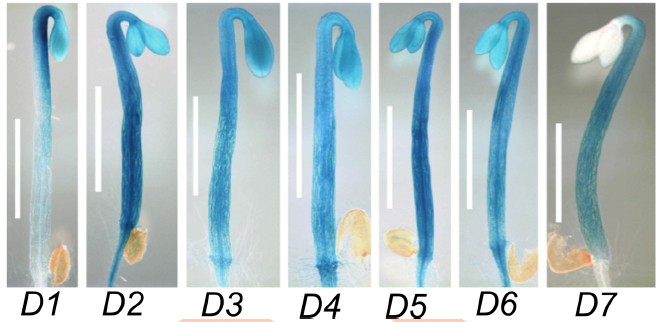博文
PLOS Genetics:拟南芥生长素诱导的细胞扩增分子机理
||
A subset of plasma membrane-localized PP2C.D phosphatases negatively regulate SAUR-mediated cell expansion in Arabidopsis
First author: Hong Ren; Affiliations: University of Minnesota (明尼苏达大学): Saint Paul, USA
Corresponding author: William M. Gray
The plant hormone auxin regulates numerous growth and developmental processes throughout the plant life cycle. One major function of auxin in plant growth and development is the regulation of cell expansion. Our previous studies have shown that SMALL AUXIN UP RNA (SAUR) proteins promote auxin-induced cell expansion via an acid growth mechanism. These proteins inhibit the PP2C.D family phosphatases (磷酸酶) to activate plasma membrane (PM; 质膜) H+-ATPases and thereby promote cell expansion. However, the functions of individual PP2C.D phosphatases are poorly understood. Here, we investigated PP2C.D-mediated control of cell expansion and other aspects of plant growth and development. The nine PP2C.D family members exhibit distinct subcellular localization patterns. Our genetic findings demonstrate that the three plasma membrane-localized members, PP2C.D2, PP2C.D5, and PP2C.D6, are the major regulators of cell expansion. These phosphatases physically interact with SAUR19 and PM H+-ATPases, and inhibit cell expansion by dephosphorylating (去磷酸化) the penultimate (倒数第二个) threonine (苏氨酸) of PM H+-ATPases. PP2C.D genes are broadly expressed and are crucial for diverse plant growth and developmental processes, including apical hook development (顶钩发育), phototropism (向光性), and organ growth. GFP-SAUR19 overexpression suppresses the growth defects conferred by PP2C.D5 overexpression, indicating that SAUR proteins antagonize the growth inhibition conferred by the plasma membrane-localized PP2C.D phosphatases. Auxin and high temperature upregulate the expression of some PP2C.D family members, which may provide an additional layer of regulation to prevent plant overgrowth. Our findings provide novel insights into auxin-induced cell expansion, and provide crucial loss-of-function genetic support for SAUR-PP2C.D regulatory modules controlling key aspects of plant growth.
植物激素生长素调控植物整个生活史生长发育的各个方面。生长素在植物生长发育中最主要的一个功能就是调控细胞扩增。作者先前的研究已经证实了SAUR蛋白通过一个酸生长机制促进生长素诱导的细胞扩增。SAUR蛋白抑制PP2C.D家族磷酸酶以激活质膜H+-ATPases,进而促进细胞扩增。然而,单个PP2C.D磷酸酶的功能还清楚。本文,作者研究了PP2C.D介导的细胞扩增调控以及其它的植物生长发育调控。PP2C.D家族的9个成员存在不同的亚细胞定位模式。遗传学试验揭示了其中三个定位于质膜的蛋白PP2C.D2、PP2C.D5和PP2C.D6是细胞扩增的主要调控子。这些磷酸酶能够与SAUR19和质膜H+-ATPase相互作用,通过去磷酸化质膜H+-ATPases倒数第二个苏氨酸抑制细胞扩增。PP2C.D基因在植株中广泛表达,并且对于多个植物生长的发育进程非常重要,包括顶钩发育、向光性及器官生长。GFP-SAUR19过表达抑制由PP2C.D5过表达所引起的生长缺陷,表明SAUR蛋白拮抗由定位于质膜的PP2C.D磷酸酶所导致的生长抑制。生长素和高温上调一些PP2C.D家族基因的表达,可能从某种层面上阻止植物的过量生长。本文的发现揭示了有关生长素诱导的细胞扩增的新的分子机理,同时也提供了SAUR-PP2C.D调控模块控制植物生长的功能缺失遗传学证据。
通讯:William M. Gray (https://cbs.umn.edu/contacts/william-m-gray)
研究方向:生长素相关的植物生长发育调控分子机制。
doi: https://doi.org/10.1371/journal.pgen.1007455
Journal: PLOS Genetics
Published date: 13 June, 2018
(P.S. 原文下载:链接:https://pan.baidu.com/s/1qFiSsqwlF_7JjmGMbedfhQ 密码:dmu6)
https://blog.sciencenet.cn/blog-3158122-1119359.html
上一篇:Plant Cell:杨树PtrEPSP基因参与木质素生物合成
下一篇:J EXP BOT:萜类合酶参与小苍兰花香分子调控
全部作者的其他最新博文
- • Plant Physiology:CsMADS3促进柑果中的叶绿素降解和类胡萝卜素合成(华中农业大学)
- • Molecular Plant:LBD11-ROS反馈调节作用于拟南芥的维管形成层增殖和次生生长(浦项科技大学)
- • Science Advances:根结线虫通过调控植物的CLE3-CLV1模块,促进侵染进程(日本熊本大学)
- • Nature Communications:油菜素内酯参与植物营养生长期转变的分子机制解析(浙江农林大学)
- • Current Biology:光合作用产生的蔗糖驱动侧根“生物钟”(德国弗莱堡大学)
- • PNAS:花同源异型基因在叶中被抑制、花中被激活的分子机制(南卡罗来纳大学)


